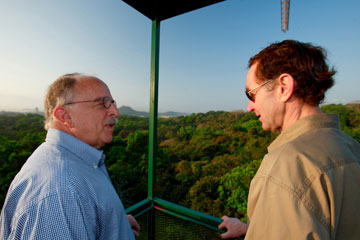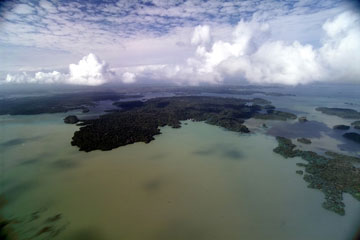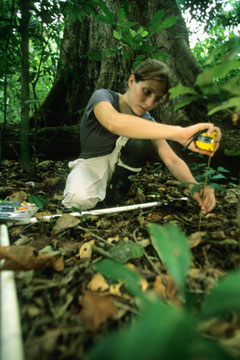HSBC gives Smithsonian $8 million to study global warming impact on forests
HSBC gives Smithsonian $8 million to study global warming impact on forests
Rhett A. Butler, mongabay.com
February 12, 2007
HSBC, one of the world’s largest banks, today announced an $8 million grant to the Smithsonian Tropical Research Institute (STRI) to fund the world’s largest field experiment on the long-term effects of climate change on forest dynamics. The grant will enable STRI to expand the research capability of its Center for Tropical Forest Science, a network of tropical forest research stations across 20 sites in 17 countries.
“With this generous grant from HSBC, Smithsonian scientists will put key scientific data in the hands of decision makers responsible for global carbon policy and the water management of the Panama Canal,” said Ira Rubinoff, director of STRI.
The grant was announced today by HSBC Group Chairman, Stephen Green, during his visit to Panama.
“We know the success of our business in the long term depends on a stable environment. We believe that by supporting this research we will more fully understand the risks and business opportunities presented by climate change, and the Smithsonian Institution is the best-equipped and experienced organization of this kind to help us understand how our global environment is changing.”
 R-L: HSBC Group Chairman, Stephen Green and Director of the Smithsonian Tropical Research Institute (STRI), Dr Ira Rubinoff in Panama at the launch of a five year US$8 million environmental partnership between the two organizations to study the impact of climate change on the world’s forests. Photographer, Christian Ziegler  Barro Colorado Island. (Photo courtesy of the Smithsonian Tropical Research Institute) |
The grant is the largest ever corporate donation to STRI, the world’s leading tropical research institute.
“HSBC’s grant will bring science to a new level by enabling us to document quantitatively some of the environmental services that tropical forests provide, such as carbon uptake and water storage. This science is critical for understanding the role tropical forests play in the functioning of our planet as a whole,” said Stuart Davies, director of the Center for Tropical Forest Science.
The funding will expand the Center for Tropical Forest Science into a Global Earth Observatory system that will be “based on the longest-running standardized forest monitoring program, covering all the major tropical rainforest areas of the world,” according to a statement from STRI. The research will begin in the Panama Canal watershed where STRI already has a well-established presence, including Barro Colorado Island, a world-renowned research facility. For the first five years, the grant will go towards research to measure the carbon storage capacity of tropical forest trees, compare changes in tropical and temperate forests (monitoring some 3 million individual trees representing more than 8,000 species), and determine the “role of forests in regulating the quality and quantity of water flow in the Panama Canal.” The grant will allow STRI to partner with other institutions working outside the tropics and enable it to strengthen outreach and educational programs that explain the importance of forests to the public.
 Liza Comita measures tropical tree seedlings in the Center for Tropical Forest Science on Barro Colorado Island, Panama. Photographer: Christian Ziegler |
“This project with the Center for Tropical Forest Science is critical to Panama,” said Joseph Salterio, chief executive officer of HSBC Bank (Panama). “The Canal is the lifeblood of the country and we know this economic engine could be threatened by changing rainfall patterns. The Canal supports a large amount of international trade and therefore is vital to international commerce.”
The forests of the Panama canal watershed have been called “the most important watershed forests for world commerce”, but they are little understood. Some hydrologists say that trees deprive the canal of water by pumping water out of the ground into the atmosphere, while others argue that forests act as a sponge, retaining groundwater during dry periods. The new grant should help shed light on the relationship between forest cover and water flow, which is particularly important given that each ship transit through the Panama requires 200,000 cubic meters of fresh water generated by the surrounding watershed. Panama recently passed a national referendum that will widen the canal. STRI says that “accurate management and forecasting of water availability will be critical to shippers and insurers,” and notes that 68 percent of the cargo going to and from the United States passes through the Canal, which is currently operating at near capacity.
HSBC’s grant will also fund research into the relationship between forests and global warming. Currently it is believed that tropical forests are helping mitigate climate change by absorbing carbon at faster rates due to higher atmospheric concentrations of carbon dioxide — now at their highest levels in 800,000 years. However no one knows how continued increases in CO2 levels and temperatures will impact carbon storage in world forests. Some models suggest that shifts in species composition and drier conditions could actually cause forests to become a net source of carbon instead of a net sink in the future. Such a change would cause a significant rise in carbon dioxide levels, worsening the effects of climate change.
This article is based on press materials from STRI














